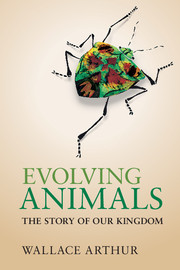Book contents
- Frontmatter
- Dedication
- Contents
- Preface
- Acknowledgements
- 1 What is an animal?
- 2 Before there were animals
- 3 How to make a fossil
- 4 The Cambrian explosion
- 5 How to make a species
- 6 Jellyfish and their kin
- 7 How to make a tree
- 8 The enigmatic urbilaterian
- 9 Animal symmetry and heads
- 10 A plethora of worms
- 11 Trends in animal complexity
- 12 Where the octopus is king
- 13 How to make an animal
- 14 Exoskeletons galore
- 15 Extinction
- 16 Mouth first, mouth second
- 17 Comparing embryos
- 18 Larvae, mouthparts and moulting
- 19 The animal toolkit
- 20 Vertebrate origins and evolution
- 21 From water to land to water
- 22 Variation and inheritance
- 23 Evolutionary novelties
- 24 Human origins and evolution
- 25 Animal plasticity
- 26 The nature of adaptation
- 27 The direction of evolution
- 28 Animal extremophiles
- 29 Extraterrestrial animals?
- 30 The ghost in the machine
- Appendix
- References
- Index
27 - The direction of evolution
Published online by Cambridge University Press: 05 August 2014
- Frontmatter
- Dedication
- Contents
- Preface
- Acknowledgements
- 1 What is an animal?
- 2 Before there were animals
- 3 How to make a fossil
- 4 The Cambrian explosion
- 5 How to make a species
- 6 Jellyfish and their kin
- 7 How to make a tree
- 8 The enigmatic urbilaterian
- 9 Animal symmetry and heads
- 10 A plethora of worms
- 11 Trends in animal complexity
- 12 Where the octopus is king
- 13 How to make an animal
- 14 Exoskeletons galore
- 15 Extinction
- 16 Mouth first, mouth second
- 17 Comparing embryos
- 18 Larvae, mouthparts and moulting
- 19 The animal toolkit
- 20 Vertebrate origins and evolution
- 21 From water to land to water
- 22 Variation and inheritance
- 23 Evolutionary novelties
- 24 Human origins and evolution
- 25 Animal plasticity
- 26 The nature of adaptation
- 27 The direction of evolution
- 28 Animal extremophiles
- 29 Extraterrestrial animals?
- 30 The ghost in the machine
- Appendix
- References
- Index
Summary
The great American palaeontologist G. G. Simpson, in discussing Darwinian and other evolutionary theories, made the following point in 1953: “The various major schools of evolutionary theory have arisen mainly from differences of opinion as to how evolution is oriented.” Of course, in the Darwinian school, natural selection is seen as the main cause of evolutionary orientation, or direction. In other words, this school of thought has it that natural selection steers evolution and thus causes particular lineages to go in one direction, say increasing body size, rather than another. This differs from the earlier Lamarckian approach, which involved the inheritance of acquired characters – now known not to occur – in the determination of evolutionary direction.
Natural selection is a systematic rather than random process. But its raw material is variation, and this derives ultimately from genetic mutation, which is often said to be random. However, this latter point needs some elucidation. A key assumption of Darwinian theory – sometimes explicit, sometimes implicit – is that the variation upon which natural selection acts is random with respect to whatever would be favoured under the prevailing environmental conditions. In other words, the variation is considered not to be biased in favour of forms that would have increased fitness. This is generally believed to be correct.
- Type
- Chapter
- Information
- Evolving AnimalsThe Story of our Kingdom, pp. 274 - 284Publisher: Cambridge University PressPrint publication year: 2014



